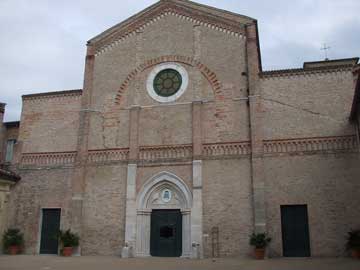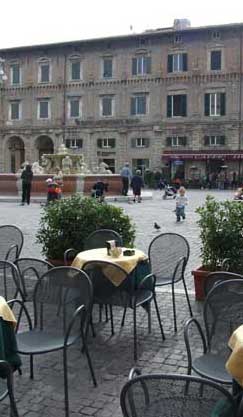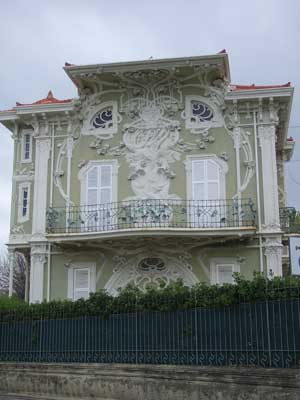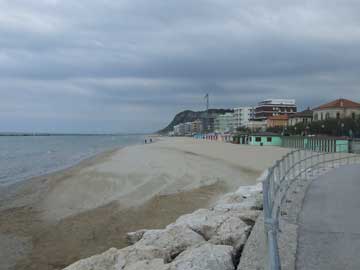About Pesaro
Pesaro, on Italy’s Adriatic coast, is not well-known to foreign travellers, but it’s a popular traditional seaside resort, and Italian visitors have been coming here to enjoy the sandy beaches for a hundred years.
Pesaro (pronounced with the stress on the first syllable) is a fairly substantial town, with a population of around 90,000; the second-largest town (after Ancona) in the region of Le Marche, on the eastern side of central Italy. The town is at the northern end of the region, near the riviera of Emilia-Romagna and the more famous resort of Rimini, and it is the capital of the province of Pesaro e Urbino. Like most Italian seaside resorts, the original settlement, dating to the Roman era, is a short distance inland, and so the centro storico – historic centre – is separated from the Mediterranean by more modern and less attractive developments of hotels and seaside dwellings.
I only visited Pesaro for a couple of hours, but it struck me as a very pleasant town with a lively atmosphere, good transport links and plenty to do for a few days, even out of season. The historic centre is appealing, and is only a few minutes’ walk from the sea-front. As well as sandy beaches it also has a little promenade where you can walk along the water’s edge – unlike many Italian resorts where fences and private beach concessions render the sea invisible to passers-by. I reckon it’s a cut above the average Italian beach resort: while Lido di Jesolo advertises catwalk underwear parades, Pesaro hosts an opera festival. A rather bizarre titbit of information is that Pesaro is twinned with Watford in England.
This is the sort of holiday destination I’d recommend for those travelling with families or in a group with varied interests. With two or three nights spent in Pesaro you could enjoy the beach, take a cultural trip to Urbino, explore the historical sights of Pesaro itself and perhaps of Rimini, 30 minutes away by train.
Find and book hotels. With location maps and guest reviews.

Rossini and the opera festival
The composer Gioachino Rossini was born in Pesaro, and his home is one of the town’s proudest tourist sights. In the composer’s honour, each summer Pesaro hosts the Rossini Opera Festival – a great time to visit for opera-lovers.
Pesaro tourist sights

There are several interesting things to see in the old town centre, which lies between the railway station and the sea. From the railway station, head to the right skirting the town walls. From Piazzale Garibaldi walk straight on along Via Branca. This is a useful principal street which cuts through the historic centre, passing through the large Piazza del Popolo, the town’s main square, where you can admire the grand Ducal Palace (Palazzo Ducale). Continuing straight on along Via Rossini, you will pass Rossini’s house and the town’s cathedral (see below) and then arrive at the modern seaside part of town. The tourist information office is on the right here in Piazzale della Libertà, and is well-stocked with excellent maps and leaflets in English. The seafront promenade lies just ahead; this is a good place to sit, look at the sea, study the tourist leaflets and plan your day. Don’t miss the fantastically elaborate villa in what Italians call Liberty style (after the London shop) on the same square. It is the Villino Ruggeri, and was built between 1902 and 1907 in imaginative art nouveau style.
Pesaro’s cathedral (Cattedrale) on Via Rossini has an attractive Romanesque facade, and a history that goes back further than the present building. Excavations have uncovered stretches of early Christian mosaics underneath the current building, dating to two earlier churches on the site. These are visible beneath glass panels in the church floor; take coins to operate the illuminations (1 when I visited).
There are a few small museums to visit in Pesaro. Rossini’s birthplace, the Casa Rossini, is in the street now named after him. This small museum is open to the public and houses various bits of memorabilia. Rossini was born here in 1792, although his family only lived in the house for a few years. The Musei Civici (town museums) consist of a ceramics museum and an art gallery (pinacoteca), where the highlight is Giovanni Bellini’s Coronation of the Virgin. The Museo Oliveriano contains archaeological exhibits, many from a nearby Iron Age necropolis at Novilara.
After a stroll along the seafront, a coffee in Piazza del Popolo and some museum time, there is still some exploring to do in Pesaro. There are more interesting churches and buildings to see; the map available at the tourist information office is an invaluable guide. The Foglia river skirts the city centre and issues into the Adriatic alongside Pesaro’s port and lighthouse. On the other side of the railway line is a large public park, the Parco Miralfiore. Further out of town are two historic villas which are worth visiting when open – check with the tourist information office in Pesaro: Villa Caprile, which has an elegant garden with fountains (gardens open on summer afternoons), and the imposing Villa Imperiale (visitable on occasional guided tours bookable through the tourist information office).
About the beaches
The central seaside promenade is alongside Piazzale della Libertà, where benches and a little headland enable holidaymakers to enjoy views over the water and along the coastline. There are sandy beaches in each direction, and another around the corner at Baia Flaminia, on the far side of the port. As normal in Italy, the beaches are packed with private beach concessions and rows of sunbeds. By the hill at the southern end of town, the Colle Ardizio, there is some free beach (spiaggia libera) if you prefer a more basic beach experience.
> More about Italian beach culture

Pesaro transport
The most convenient airports for Pesaro are at Ancona and Rimini (both served by budget airline Ryanair from the UK). Pesaro is on a railway line which connects Bologna and Rimini with Ancona and there are frequent trains along this stretch of coast, making it easy to get from one resort to another. Different types of train run on the route and you will need to buy the correct ticket for the type of service you are using. Regionali, regional trains, are slower but a lot cheaper than the fast Eurostar and Intercity services. The railway station is on the inland side of the city centre, and is about a twenty-minute walk from the sea
The interior of the Marche region is very hilly and most towns are connected by buses. Pesaro is at the centre of a local network; many bus services leave from alongside the railway station and others from the bus station in Piazzale Matteotti; you could collect timetable information here or from the tourist information office by the sea.
Things to do around Pesaro
Although it only takes a short time to visit Pesaro’s tourist sights, it is really worth exploring the area around the town. Inland are attractive rolling green hills and places of interest; with a bit of planning you could visit some of these by public transport. Other resorts along the coast, such as Rimini and Fano, are easy to reach from Pesaro using the railway line which follows the coast. The most cultural day out would be a trip to Urbino, the attractive hilltop town famous for having been the seat of Duke Federico of Montefeltro, whose vast Renaissance palace is open to the public. Frequent buses leave Pesaro railway station for Urbino; some are slow local services and others, fractionally more expensive, provide a 45-minute fast connection.
> Pesaro hotels, B&Bs and holiday rentals
On this site
Useful external links
Adriabus – local bus services
